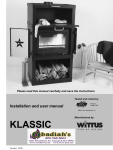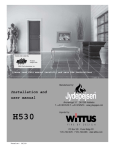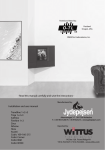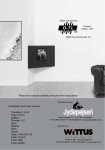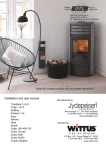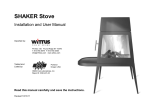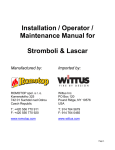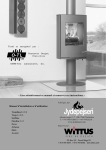Download Wittus Klassic User manual
Transcript
Please read this manual carefully and save the instructions Tested and Listed by: Installation and user manual C US Portland Oregon USA OMNI-Test Laboratories, Inc. Manufactured by: KLASSIC PO Box 120 Pound Ridge NY T.914.764.5679 F.914.764.0465 www.wittus.com Version: 10/09 - TABLE OF CONTENTS 1. INTRODUCTION ......................................................................................... 2 Safety and Environmental Testing ..........................................................................................3 Features and Items Included...................................................................................................3 2. INSTALLATION .......................................................................................... 3 Precautions .............................................................................................................................3 Specifications ..........................................................................................................................4 Chimney ..................................................................................................................................5 3. SENSIBLE WOOD BURNING .................................................................... 9 Proper wood burning ...............................................................................................................9 Incorrect wood burning............................................................................................................9 Technical information on wood burning...................................................................................9 Types of fuel and heating values...........................................................................................10 Fuel .......................................................................................................................................10 4. OPERATING INSTRUCTIONS ................................................................. 11 First Fire ................................................................................................................................11 Lighting the stove ..................................................................................................................11 Refueling ...............................................................................................................................11 Baking ...................................................................................................................................11 5. TROUBLESHOOTING .............................................................................. 12 6. MAINTENANCE ........................................................................................ 13 Replacing the gasket on the door..........................................................................................13 Replacing the gasket on the glass ........................................................................................13 Disoposal of ashes ................................................................................................................13 Creosote – formation and need for removal..........................................................................13 Interior cleaning.....................................................................................................................13 7. WARRANTY.............................................................................................. 14 8. SPARE PARTS LIST ................................................................................ 14 1. INTRODUCTION Congratulations on your new KLASSIC wood burning stove/fireplace. As a product of superior quality and efficiency, we wish you many years of warmth and pleasure. We are asking you to: PLEASE READ THIS ENTIRE MANUAL BEFORE YOU INSTALL AND USE YOUR NEW STOVE. FAILURE TO FOLLOW INSTRUCTIONS MAY RESULT IN PROPERTY DAMAGE, BODILY INJURY, OR EVEN DEATH. KEEP IT HANDY FOR EASY REFERRAL. Please take particular note of this symbol: This indicates special attention. Version: 10/09 Page 2 Safety and Environmental Testing The H530 Insert/Firebox for the Klassic has been tested by OMNI-Test Laboratories, Inc. of Portland, Oregon and is listed to UL 1482 and ULC S628. It is also EPA certified. Features and Items Included Your KLASSIC has a built-in convection system, so it creates air circulation in the room to spread the heat faster and more evenly. The stove has a small "cool" handle, which enables you to open the door without the use of a glove (however, always use caution when touching areas where HOT surfaces are located). Included in the firebox are: • a thermometer • an oven mitt • an easy to use lighter • a can of touch-up paint (Remove from the stove!) 2. INSTALLATION Precautions IF THIS STOVE IS NOT INSTALLED PROPERLY, A HOME FIRE MAY RESULT. TO REDUCE THE RISK, PLEASE CAREFULLY FOLLOW THE DIRECTIONS FOR INSTALLATION. First, the stove must be installed according to the directions in this manual. Consult your local Building Inspector or Fire Marshall before installation about restrictions and installation inspection requirements in your area. Also, in some areas a "special permit" is required. Not for use in a mobile home. If utilizing an existing chimney, it is suggested that you have a professional mason or stove installer do a complete check-up of your chimney, liner, and flue. In order for the stove to work and draw properly, sufficient air is important! Be especially aware of any mechanical fans (e.g. kitchen or bathroom) that may affect the proper draw. When installing the stove, the heat distribution to other rooms should be taken into consideration. In addition, make sure that the floor and sub-flooring is designed to carry the extra weight of the stove. A floor plate of non-combustible material (tempered glass floor plates are acceptable) must cover under the stove and extend 16" (41 cm) (18" (45 cm) in Canada) in front of the stove door, 8" (20 cm) beyond the sides of the fuel-loading door, and under the pipe and 2" (5 cm) beyond each side for back venting. In Canada, the 8" (20 cm) floor protection is required beyond the sides of the stove and in the back of the stove (0" in the back for the US). The Klassic has a heating capacity of approximately 1,076 ft2 (100m2) based on a standard ceiling height. Version: 10/09 Page 3 Specifications UL 1777 Listed chimney liner (with a 6” (15cm) diameter) up through the block off plate of an existing masonry chimney, a zero-clearance chimney, or Class A, UL-103 HT, 6” (15cm) diameter chimney Dimensions (h x w x d) – 60” x 32” x 22” (152cm x 81cm x 56cm) Firebox Dimensions (h x w x d) – 14” x 24” x 12” (35cm x 60cm x 30cm) Thermal Output – 20,000 BTU (6 kW); range is 11,100-28,800 BTU Approximate heating area – 600-1,500ft2 Minimum stove pressure at above output – 15 Pascals Efficiency – 75% Tested EPA emission particulate rate – 6.6 grams/hour Minimum distances from edge of stove to combustible material – as shown below: Wall View Corner View A= B= C= D= E= F= G= H= Distance to side wall – 12”(30cm) Distance to back wall – 17”(43cm) Corner distance to side walls – 7”(18cm) Connector pipe to side wall – 25”(64cm) Connector pipe to back wall – 18”(46cm) Corner pipe to side walls – 18”(46cm) Distance to furniture – 36”(92cm) Front floor protection (to unprotected combustible floor) – US is 16”(41cm); Canada is 18”(46cm) I = Side floor protection – US is 8”(20cm) from sides of fuel-loading door; Canada is 8”(20cm) from the sides of the stove J = Back floor protection – US is 0”(0cm); Canada is 8”(20cm) Ceiling to top of stove – 36”(92cm) Ceiling to connector pipe – 18”(46cm) Note: A heat shield or protective wall may be used to reduce clearances if approved by the regulatory authority. Clearances to noncombustible materials are 2” (5cm), but note that “noncombustible” must be solid cement or block (not brick or tile over combustible material). Version: 10/09 Page 4 Chimney The Klassic must be installed using a Class A UL 103 HT approved factory-built chimney system or a code-approved masonry chimney with a flue liner. In Canada, the installation must conform to NFPA 211 or CAN/CSA-B365. The chimney must extend through the roof at least 3’ (1 m), and 2’ (6 m) above any structure within 10’ (3 m). The condition of the chimney and height is very important. We recommend a minimum height of 10’ (3 m) above the stove collar. However, additional chimney height may be required to maintain adequate draft - consult you dealer. Note! Mount the special collar using the included hardware. When installing the first piece of pipe (at the stove), place the pipe inside the collar, that is designed so any moisture or creosote will drip back into the stove and burn away. Install the remaining stovepipe segments with the crimped end down whenever possible. Required Installation Components A. Chimney cap B. Insulated chimney C. Storm collar D. Roof flashing E. Ceiling support box or joist shield / firestop spacer F. Chimney connector pipe Chimney connector Aluminum and galvanized steel pipe is not acceptable for use with the wood stoves. These materials cannot withstand the extreme temperatures of a wood fire and can give off toxic fumes when heated. Do not use connector pipe to go through a wall or ceiling. Each chimney connector or chimney connector section must be installed to the stove flue collar and to each other with the male (crimped) end toward the stove. A B C D B E F Version: 10/09 Page 5 This prevents any amount of condensed or liquid creosote from running down the outside of the pipe or the stove top. All joints, including the flue collar connection must be secured with three sheet metal screws to ensure that the sections do not separate. For the best performance the chimney connector should be as short and direct as possible, with no more than two 90° elbows. The maximum horizontal run is 36" and a recommended total length of single wall stove pipe connector should not exceed 10 feet. Connector pipe over 10 feet must be double wall from the stove collar (not mixed with single wall except at a masonry thimble per manufacturer's installation guide). Always slope horizontal runs upward ¼ inch per foot toward the chimney. Note the connector pipe should not pass through an attic or roof space, closet or similar concealed space, or a floor or ceiling. DO NOT CONNECT THIS STOVE TO A CHIMNEY FLUE OR AIR DISTRIBUTION DUCT OR ANY SYSTEM SERVING ANOTHER APPLIANCE. For venting vertically into a Class A chimney, single wall pipe (at least 24 gauge) may be used in the room where the stove is installed. Refer to the manufacturer’s instructions for the connection to the listed chimney. The chimney / chimney connector must not be smaller than 6" (15 cm) in diameter. For venting directly into a masonry chimney or through a thimble, the top of the single wall pipe must be at least 18" (46 cm) below a combustible ceiling and conform to NFPA 211 or CAN/CSA-B365 guidelines and methods. See diagram below. For rear venting or other not listed configurations, consult the local building codes and follow the NFPA 211 or CAN/CSA-B365 guidelines. If the chimney connector is fitted with a baffle, it must be manually operated, visibly placed for ease of use, and must not close completely. Consult your chimney expert if you have any questions. Make sure that there is easy access to the chimney clean-out door. Read the instructions on the following page carefully before connecting: “Chimney Connector Systems and Clearances from Combustible Walls for Residential Heating Appliances”. Version: 10/09 Page 6 Chimney Connector Systems and Clearances from Combustible Walls for Residential Heating Appliances Version: 10/09 Page 7 Before installation, it is also important to check that the Vermiculite panels are correctly fitted in the combustion chamber. The wood holder in the combustion chamber is not to be removed. On some baffle plates you will find a metal band. This band is mounted for transport protection only, and should be removed. Heat generation and distribution The Klassic is really two stoves in one. Inside is the actual stove, produced from strong steel plates, and on the outside a covering of steel. There are two major types of heat: radiant heat and convection heat. In the airspace between the actual stove and the covering, convection heat is generated. The air is drawn in at the bottom of the firebox. The heated air then flows upwards and begins to circulate throughout the room, subsequently dispersing into the neighboring rooms, providing perfect heat distribution. So the question of where to position your stove is an important one. The ideal location is fairly central, in the room where you require most heat. Unlike radiant heat, which is highly concentrated around the stove, convection heat flows upwards and spreads to neighboring rooms. It is very important to ensure that your chimney has a good draft. Your dealer or your chimney sweep will be able to guide and advise you on your chimney conditions. Follow the operating instructions and use seasoned wood, which burns easier and cleaner in the combustion chamber, until a proper draft is obtained. For further information on using wood and lighting and managing the fire, please refer to sections 3 and 4. Please note that the stove paint will harden during the first few initial fires. This means that the stove will generate smoke and an odor of paint, which will dissipate after about an hour of operation. It is a good idea to ensure effective ventilation during this phase. If ventilation is not adequate, smoke alarms may be activated. Also, avoid touching the stove during the curing process. The stove will expand and contract during the lighting and cooling phase, possibly resulting in creaking noises. This phenomenon is completely normal for steel stoves. Version: 10/09 Page 8 3. SENSIBLE WOOD BURNING Proper wood burning When dry wood is burned in a wood-burning stove the following process occurs (over a period of approx. 1 hour): - After lighting the log starts to dry and heats up. - After drying the temperature of wood rises to approx. 300–400°F (150-200°C) and is converted into combustible gases/charcoal. - As the wood is gasified a certain portion of the gases produced burn and are converted into carbon dioxide and water. During this phase the temperature rises to around 1100-1500°F (600-800°C) and a plentiful supply of air is required. If the air supply is accidentally reduced, the flames will be smothered, but this will not stop the conversion of the wood into gas. The unburned gas will then flow out into the chimney, causing a nuisance outdoors and build up of creosote. - Next-charcoal will burn, which requires very little air supply. Finally, new wood must be laid on the glowing charcoal cinders. Warnings - It is extremely important to ensure that you do not overheat your stove, as this can cause irreparable damage. This kind of damage is not covered by the warranty. Extremely high combustion temperatures can occur when using inappropriate fuel, such as kiln-dried wood, coal, pressure-treated wood, scrap wood. NEVER USE GASOLINE, GASOLINE-TYPE LANTERN FUEL, KEROSENE, CHARCOAL LIGHTER FLUID, OR SIMILAR LIQUIDS TO START OR ‘FRESHEN UP’ A FIRE IN THIS HEATER. KEEP ALL SUCH LIQUIDS WELL AWAY FROM THE HEATER WHILE IT IS IN USE. HOT WHILE IN OPERATION. KEEP CHILDREN, CLOTHING AND FURNITURE AWAY. CONTACT MAY CAUSE SKIN BURNS. DO NOT STORE SOLID FUEL WITHIN HEATER INSTALLATION CLEARANCES OR WITHIN THE SPACE REQUIRED FOR FIRE LIGHTING AND ASH REMOVAL. Incorrect wood burning Too much air supplied to the combustion process causes an uncontrollable fire that will heat the entire stove very rapidly to an extremely high temperature. This can happen if you fire with conditions that produce an extra-strong draft in the chimney. Never fill the stove completely with wood. It is better to heat a stove up slowly. This will prevent damage to welds and annealing of the iron. Overfilling the firebox also substantially reduces the useful life of the vermiculite panels, as cracks are more easily caused. The log size should be about 2” (5cm) less than the width of the firebox. Start slowly with a “normal” fire from the bottom, and slowly build it up to a maximum of three logs. Technical information on wood burning 1 kilo of dry wood is made up of 20% water, with the remaining 80% divided into 60% gas and 20% charcoal. The 60% gas only contains around half the energy content of the wood, while the 20% charcoal contains the other half. To achieve optimum combustion, the temperature must reach 11001500°F (600-800°C). Reload with a few pieces of wood at a time. If too much wood is placed on a layer of embers, the air supplied will not be sufficient to attain the required temperature, and the gases will disappear out through the chimney unburned. It is vital to supply air to the fire immediately after adding fuel, so there are flames in the firebox, and the gases burn. Remember that three logs will burn just as quickly as one. The quantity of firewood determines the heat emission - the more heat you require, the more wood you should add at each refueling. Version: 10/09 Page 9 Types of fuel and heating values Combustion involves conversion of the fuel from solid form into gases, water vapor and charcoal. The heating value is an expression of the content of combustible gases - stated in kcal/kg. All wood has roughly the same heating value per kilogram. The lighter the wood, the more that must be used to achieve the same heating value as with a heavier species of wood. Type of wood Beech and oak Ash Maple Birch Mountain pine Fir Poplar Dry wood - Lbs./ft3 (Kg/m3) 36.2 (580) 35.6 (570) 33.7 (540) 31.8 (510) 30.0 (480) 24.3 (390) 23.7 (380) Compare to Beech 100% 98% 93% 88% 83% 67% 65% As mentioned, air-dried wood contains around 20% water, corresponding to a heating value of approx. 4 kWh/kg equivalent to approx. 3440 kcal/kg (1kW = 860 kcal). Warning! NEVER burn treated/painted wood, laminated plastic, plywood, chipboard, refuse, milk cartons, printed matter or similar. Use of such materials will invalidate your warranty, as this may emit toxic, corrosive and hazardous fumes when burned. They may also cause a build-up of the toxic gas dioxin, which is damaging to the stove and the environment. Fuel Recently-felled wood contains 60-70% water and must therefore be seasoned before it can be used in a wood burning stove. It must be cut, split and air dried, and must contain no more than approx. 25% water before use. This equates to the wood being left in the open for approx. 1 year - covered only to protect against rain. It is very important to always use dry wood. Damp wood requires a lot of air for combustion, as extra energy in the form of heat is needed to dry it out. Heat emission is therefore minimal. When wood is burned slowly, it produces tar and other organic vapors, which combine with expelled moisture to form creosote. The creosote vapors condense in the relatively cool chimney flue of a slow-burning fire. As a result, creosote residue accumulates on the flue lining. When ignited, this creosote makes an extremely hot fire. The chimney and chimney connector should be inspected at least once every two months during the heating season to determine if a creosote buildup has occurred. If creosote has accumulated, it should be removed to reduce the risk of a chimney fire. Version: 10/09 Page 10 4. OPERATING INSTRUCTIONS First Fire Once your Klassic stove is installed and all instructions have been read, the first fire can be started. However, please take careful note of the following: - Your new stove should be broken in gently for top performance and to prevent paint damage, cracks in the vermiculite or firebox lining, and excessive wear and tear. - The baffle plate and vermiculite panels may crack under hard impact. These are not covered by the warranty, so avoid tossing the wood in the firebox. - Avoid touching the metal during initial fires, as the paint is hardening at this stage. Otherwise this may mar the paint. It is a good idea to ensure effective ventilation during the first firing, as the stove will generate smoke and an odor of paint. The smoke and paint odor will dissipate after about 1 hour’s operation and is not hazardous to health. Do not use a grate or elevate the fire – build wood fire directly on hearth. Lighting the stove 1. Open the outer doors first. 2. Make sure the air vent is in the fully open position (move the handle to the left as shown by the wide end of a triangle). 3. Add crumbled paper/firelighters and kindling wood to the bottom of the fire box (combustion chamber). The kindling (about 3 lbs or 1.5 kg) is to be built up crosswise. 4. Light the fire. The door should be ajar for a couple of minutes during the lighting phase. 5. Once the flames have taken a good hold of the kindling, the door can be shut. 6. The air vent should be adjusted down toward the right after approx. 10 minutes (primary air); how much depends on the chimney draft - however, the air supply must be diminished to the point where you obtain steady and calm flames. Once there is a good bed of embers in the stove, you can add wood. It is important not to open the door while there are flames in the stove, as this may cause smoke to flow out into the room. Add wood on the basis of your heating requirements. However, never add more than 4.4 lbs or 2 kg of wood every 1.5–2 hours. Please remember that the exterior surfaces especially the top and front of the stove in particular will become very hot during burning. Refueling 1. Open the air vent to the maximum (to the left). To minimize the back draft, the door should be ajar for about one minute before you open it completely. 2. Open the door slowly. Add 2 – 3 pieces of firewood to the combustion chamber. 3. Close the door. 4. Turn down the air supply (toward the right) when the fire has caught the wood, to obtain steady and calm flames. Baking The upper compartment easily turns into a convenient baking/cooking compartment by closing the upper baking door, and closing the top louvers on each side of the top of the stove. The natural 2" thick Brazilian soapstone baking liner provides heat retention and consistent even baking. Use the included thermometer and have fun. The baking door can also be removed and the area used for warming. Version: 10/09 Page 11 5. TROUBLESHOOTING Combustion problems can arise if the combustion conditions are not optimal. This can be corrected by following the advice given below. Lighting and burning problems are usually due to wet wood or insufficient draft. Version: 10/09 Page 12 6. MAINTENANCE Gaskets and vermiculite panels are parts which need to be replaced from time to time – depending on how much you use your stove. In some cases, you may need to replace them every year, while in others, replacement every second or third year will suffice. As a rule of thumb, gaskets need to be replaced when it has become flattened and the door no longer fits tightly against the front of the stove. You can purchase gaskets – with adhesive – from your local dealer. The vermiculite panels must be replaced when they have worn thin, or when cracks – if any – become so wide that you can actually see steel through them. If the panels are not replaced at such time, they will lose their capacity to insulate and reflect heat. Use only authentic spare parts! Movable and mechanical parts (closing mechanisms, hinges etc) should be greased once a year with a heat-resistant lubricant. You should have your stove checked regularly by a qualified professional to ensure the optimal function of the stove at all times. Do not make modifications, since any unauthorized changes to the design of the stove will also invalidate the stove guarantee and test results. Replacing the gasket on the door 1. Remove the gasket from the inside edge of the door and clean the sealing track (there is no need to remove the door from the stove). 2. Apply a layer of fire-resistant adhesive to the track where the old gasket was affixed. 3. Press (while stretching it out) the new gasket into the track. 4. Close the door and let the adhesive set for approx. 1 day before opening the door again. If the adhesive has not hardened sufficiently before the door is opened again, the gasket may fall out. Replacing the gasket on the glass 1. Open the door. 2. On the inside of the door, in each corner of the glass panel, there is a fastening that must be loosened so that each fitting can be turned away from the glass panel. 3. Repeat this procedure for all the fittings and remove the glass panel. 4. Remove the old strip from the glass panel. 5. Fit a new gasket around the glass panel. To replace the glass panel, simply reverse the process described above. Disoposal of ashes Ashes should be placed in a metal container with a tight fitting lid. The closed container of ashes should be placed on a noncombustible floor or on the ground, well away from all combustible materials, pending final disposal. If the ashes are disposed of by burial in soil or otherwise locally dispersed, they should be retained in the closed container until all cinders have thoroughly cooled. Creosote – formation and need for removal Refer to the Section on Fuel on Page 10. Insure there is sufficient air supply to avoid incomplete combustion and formation of creosote. Interior cleaning Make sure it is possible to access the chimney for sweeping and cleaning. Version: 10/09 Page 13 7. WARRANTY The Klassic comes with a 5-year warranty. The warranty covers defects in materials or workmanship. Any claims during the warranty period should be directed to the dealer who sold the stove. All stoves from Wittus come with their own individual serial number on the type plate on the top of the firebox. Record this number and keep it in a safe place. Provide the stove model and serial number to your dealer in connection with service tasks. In the event of warranty repairs, a signed and dated invoice must also be produced, showing the dealer’s name. The warranty does not cover dismantling, transport and reassembly of your stove. No compensation will be granted for: - Damage during transport - Damage to other articles resulting from use of the stove - Damage arising from misuse, such as overheating. Read the operating instructions carefully to avoid such problems. - Damage resulting from a failure to follow the directions in the operating instructions. Normal wear and tear parts such as vermiculite panels, baffle plates, and gaskets are not covered by the warranty. Furthermore, glass, ceramic tiles, and soapstone are not covered by the warranty. If any of the above mentioned need replacing, new parts can be ordered from your dealer. 8. SPARE PARTS LIST Article No. 413003-00 413004-00 413002-00 413001-00 413000-00 400106-00 Version: 10/09 Article description Vermiculite bottom panel Vermiculite baffle plate Vermiculite rear panel Vermiculite side panel Set of 4 vermiculite panels Glass with gasket Wood holder Gasket set with adhesive Dimensions H x W x D (mm) 305 x 299 x 25 558 x 300 x 28 637 x 247 x 20 430 x 305 x 20 559 x 360 x 4 60 x 43 Page 14














